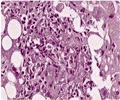
Using mice, Kash et al., from the National Institute of Allergy and Infectious Diseases (NIAID) and the Institute for Systems Biology (ISB), teased the problem apart. They infected some mice with the seasonal flu virus and others with the 2009 pandemic strain and waited 48 hours for the influenza to take hold. Next, they exposed some of the mice to the bacterium Streptococcus pneumoniae, one of the leading causes of pneumonia.
In mice that were only given either of the flu viruses, influenza had the same effects it has in humans, including weight loss, but all the mice infected with influenza alone survived. The mice infected with seasonal influenza and S. pneumoniae had slightly enhanced lung tissue damage, but they all survived the dual infections.
In contrast, all the mice co-infected with both the 2009 pandemic flu and S. pneumoniae showed severe weight loss and 100% mortality. The lung tissues of the dead mice revealed that the alveoli were severely inflamed and the surfaces of the bronchioles were wiped clean of the protective layer of cells called the epithelium. There was also increased bacterial replication in the lungs of the co-infected mice, a sign that the bacteria were thriving there.
Looking at the mouse genes that were expressed during infection revealed more details about how the pandemic influenza virus sets the stage for lethal bacterial infections. Mice infected with the pandemic flu virus and S. pneumoniae had a similar inflammatory response as the other mice, but they lack responses that would repair and regenerate their damaged epithelial cells, those protective tissues that would otherwise keep bacteria from penetrating to deeper layers of tissue.
All these factors add up to big problems in the lung: as compared with seasonal flu, infection with the pandemic strain of flu was associated with more extensive damage to the epithelium that requires more extensive tissue repair. This opens the body up to attack from bacterial invaders, including Streptococcus pneumoniae.
Advertisement
"One implication is that if you can prevent the bacterial infection, you may be able to prevent a significant fraction of the pneumonia that leads to death. There may be a role for antibiotics in the severe pneumonias that follow influenza," says Klugman.
Advertisement
Source-Eurekalert












